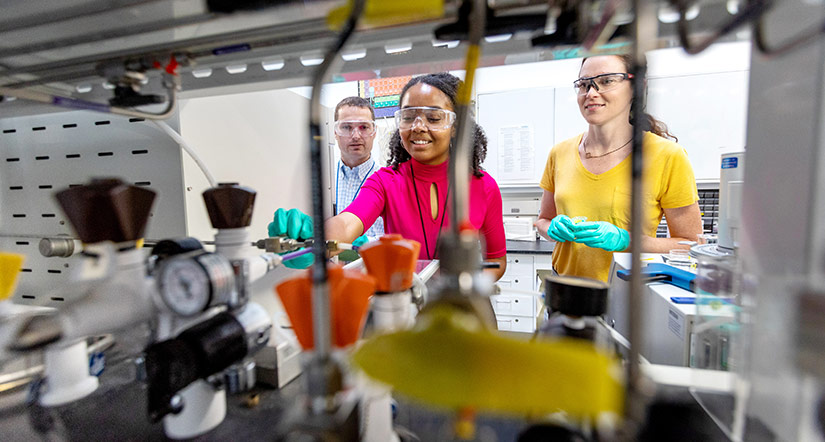Meet the 2022–2023 JUMP Into STEM Challenge Winners
National Building Science Competition Inspires Students' Unique Perspective on Today's Industry

The 2022–2023 JUMP into STEM Challenge Winners have been announced, featuring six teams of college students with diverse backgrounds and academic majors exploring solutions toward a clean energy future through building science.
Over the past five years of the competition, the National Renewable Energy Laboratory (NREL) and Oak Ridge National Laboratory (ORNL) have provided program leadership and student mentorship while promoting careers in building science to students with a broad array of perspectives. In fact, according to a recent impact study conducted by NREL, more than 47% of previous participants surveyed stated that JUMP into STEM is or was influential in deciding on their career paths, and 41% of JUMP into STEM participants currently work in fields related to energy or energy efficiency.
NREL researcher Kim Trenbath, who serves as innovation lead for systems technology research and development in the Building Technologies and Science Center at NREL, is one of the managers of the program.
"This year's Challenge Winners are so inspiring and continue to show promise for the future of buildings research," Trenbath said. "The competitive field of submissions we received demonstrates how the next generation is ready to respond to the demands of climate change."
This year's competition called upon student teams to find innovative solutions for electrifying, decarbonizing, and increasing resiliency of the built environment.
JUMP Into STEM Challenge 2022–2023 Winners and Runners-Up
Curb Your Carbon Challenge
Winner
Composite Beam Machine
Vanderbilt University
Arielle Kopp (Engineering Science), Jacqueline Quirke (Civil Engineering), Alexandra Filipova (Engineering Science, Applied Math), and Maggie Chudik (Civil Engineering)
Steel is a major component of buildings structural materials, but research related to reducing the embodied carbon content of the material may not come soon enough to meet demand and leave a shortage of recycled steel. The student team from Vanderbilt University created a machine that makes composite steel-timber beams. Composed of both steel and cross-laminated timber, the beams provide strong, yet sustainable, structural support for buildings. This solution helps reduce the demand for recycled steel, creates jobs, and increases air quality for communities near recycled steel plants.
Runner-Up
Carbon-Negative Building Materials: Building a Greener Tomorrow
Colorado School of Mines
Colleen Moauro (Advanced Energy Systems), Tyler Fenton (Mechanical Engineering), Molly Maksin (Environmental Engineering), and Zane Prose (Mechanical Engineering)
Cement remains the backbone of the buildings industry, and yet the material continues to contribute to global CO2 emissions. The team from the Colorado School of Mines designed a concrete alternative called LignoResin, made from an abundant byproduct of several industries, such as the paper and pulp industry, to provide a cheaper and more sustainable option to replace concrete for use in green construction materials.
It's Electric Challenge
Winner
Upcycle Old Electric Vehicle Battery Modules for Backup Power Systems in Rural Areas With Uncertain Power Supply
Indiana Institute of Technology
Mechanical Engineering students Dante Siracusa, Kennedy Moonin, Lindsey Albrecht, and Jacob Frogge
The rise of electric vehicles requires a solution for handling batteries at the end of their functional lives. The team from the Indiana Institute of Technology proposes repurposing electric vehicle battery modules to provide backup solar and electric power in low- to moderate-income and rural communities.
Runner-Up
Solar Savings Web Estimator
Georgia Institute of Technology
Ila Sharma (Computer Science), Patrick Young (Industrial Engineering, Math), Joelle Dlugozima (Public Policy), and Gururaj Deshpande (Biomedical Engineering)
The team from the Georgia Institute of Technology focused on raising awareness for and easing the incorporation of rooftop solar panels into low-income housing projects. Their web estimator allows people in Atlanta neighborhoods to see the average cost savings, based on their current energy usage, and tax breaks they could receive if they decided to install solar power.
Sustainable and Resilient Challenge
Winner
An Inquiry Into Rainwater Harvesting for the Supplementation of Water Infrastructure During Times of Crisis
Georgia Institute of Technology
Daksh Sehgal (Computer Science), Yash Gupta (Computer Science), Vibha Narasayya (Biomedical Engineering), and Krishnav Bose (Computer Science)
Water crises can cause great damage to infrastructure, and due to climate change, crises like these have become more common. The Georgia Institute of Technology team designed a rainwater collection system to help low-income neighborhoods—such as those in Jackson, Mississippi. Social media campaigns would address public concerns of rainwater quality and present the benefits of rainwater harvesting systems.
Runner-Up
Solar Success Loans for Baltimore Resilience and Sustainability
Johns Hopkins University
Hanting Wong (Civil Engineering), Brennan Hughes (Applied Math and Statistics), Cecilia Doyle (Civil Engineering), and Helen Hu (Mechanical Engineering)
As a result of the changing climate, the number of severe weather events is expected to increase. To address the disproportionate effects of severe weather events for marginalized communities, the team proposes "Solar Success Loans" to help these communities develop solar energy systems that enable residents to afford more electricity—such as air conditioning.
Coming Up Next: JUMP Into STEM Final Competition
JUMP into STEM finalists will present solutions to the challenge topics in person during the 2022–2023 Final Competition, which will be held January 26–27 at NREL.
During the event, participants will present to a panel of judges, learn about career paths in building science, network with experts in the field, tour the national laboratory facilities, and more. To culminate the Final Competition, winners will be announced live and offered 10-week, paid internships at NREL, ORNL, or Pacific Northwest National Laboratory (PNNL), where they will gain hands-on experience and receive invaluable mentorship.
JUMP into STEM is supported by the U.S. Department of Energy. Visit the Building Technologies Office website for more information on energy-efficient building initiatives.
This article has been updated to reflect an editorial change made after its original publication.
Last Updated May 28, 2025
